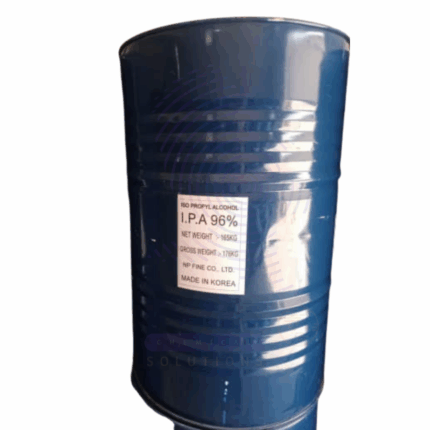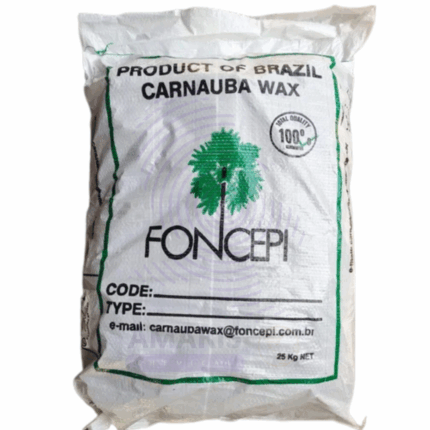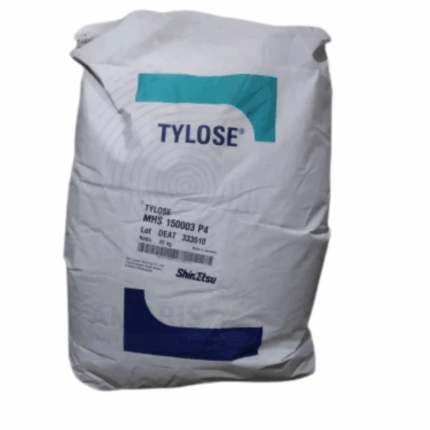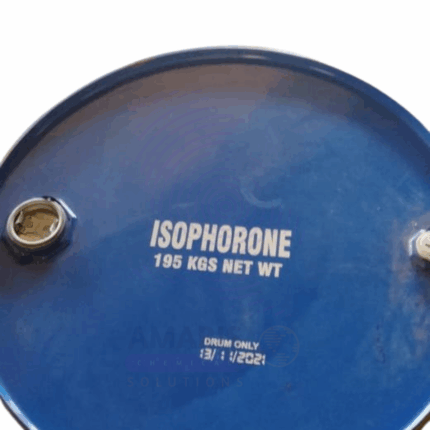
Isopropyl Alcohol Grade Tech
$ 4.00 Original price was: $ 4.00.$ 3.79Current price is: $ 3.79.
Isopropyl Myristate
Whatsapp Order
Isopropyl Myristate is a clear, colorless, and oily liquid ester formed by the reaction of isopropyl alcohol and myristic acid. It has a mild, pleasant odor and excellent spreading properties. IPM is widely used in cosmetics, pharmaceuticals, and industrial applications as an emollient, solvent, and penetration enhancer due to its ability to improve texture and absorption of topical formulations.
Description
Table of Contents
Toggle
Isopropyl Myristate (IPM)
Primary Uses
- Cosmetic and Personal Care Industry
- Used as an emollient and moisturizer in creams, lotions, sunscreens, deodorants, and makeup products for smooth, non-greasy skin feel.
- Functions as a penetration enhancer facilitating deeper delivery of active ingredients through the skin.
- Acts as a solvent for fragrances, oils, and other cosmetic ingredients improving formulation stability and texture.
- Pharmaceutical Industry
- Utilized in topical creams, ointments, and gels to improve absorption of drugs through the skin.
- Used as a vehicle for transdermal drug delivery systems.
- Fragrance and Perfume Industry
- Serves as a solvent and fixative to improve scent dispersion and longevity in perfumes and colognes.
- Industrial Applications
- Applied as a lubricant and anti-static agent in textile, plastics, and rubber industries.
- Used in formulations of insect repellents and pesticide carriers.
Secondary Uses
- Food Industry
- Occasionally used as a flavor carrier or additive in specific food-grade applications (subject to regulatory approval).
- Hair Care Products
- Added to shampoos, conditioners, and styling products to enhance smoothness and reduce greasy residue.
- Cleaning and Polishing Products
- Used in specialized cleaning formulations and polishes for its lubricating and spreading properties.
- Veterinary Applications
- Employed in topical formulations for animals as a skin conditioner and drug delivery enhancer.
KEY ATTRIBUTES
- Basic Identification Attributes
- Chemical Name (IUPAC): Propan-2-yl tetradecanoate
- Common/Trade Name: Isopropyl Myristate; IPM
- CAS Number: 110-27-0
- HS Code: 2915.70.00
- Synonyms: Isopropyl tetradecanoate; IPM
- Physical & Chemical Properties
- Physical State: Clear oily liquid
- Color & Odor: Colorless; mild, pleasant odor
- Boiling Point: 280–285 °C
- Melting Point: −9 °C
- Density: 0.86 g/cm³ (approx.)
- Solubility: Insoluble in water; soluble in most organic solvents
- Flash Point: 118 °C
- Safety & Hazard Attributes
GHS Classification:
- Not classified as hazardous under typical use
- May cause mild skin or eye irritation in sensitive individuals
Toxicity:
- Low toxicity; generally regarded as safe in cosmetic and pharmaceutical use
Exposure Limits:
- No established occupational exposure limits
- Storage & Handling Attributes
Storage Conditions:
- Store in a cool, dry, well-ventilated area away from strong oxidizers
Container Type:
- Stored in tightly sealed plastic or metal containers
Shelf Life:
- Stable for 2–3 years if stored properly
Handling Precautions:
- Avoid prolonged skin contact and inhalation of vapors
- Use appropriate PPE when handling in bulk
- Regulatory & Compliance Attributes
- Approved for use in cosmetics and pharmaceuticals by FDA, EMA, and other regulatory bodies
- Complies with REACH and other chemical safety standards
- Must be labeled according to cosmetic ingredient regulations
- Environmental & Health Impact
- Biodegradability: Readily biodegradable
- Ecotoxicity: Low toxicity to aquatic organisms
- Bioaccumulation: Not expected to bioaccumulate
- Carcinogenicity/Mutagenicity: Not classified as carcinogenic
SAFETY HANDLING PRECAUTIONS
- Safety Handling Precautions
PPE Required:
- Gloves and goggles recommended during handling of bulk material
Handling Guidelines:
- Avoid direct skin and eye contact
- Ensure adequate ventilation during use
Storage Measures:
- Keep containers tightly closed and away from heat sources
- First Aid Measures
- Inhalation: Move to fresh air; seek medical attention if symptoms develop
- Skin Contact: Wash thoroughly with soap and water; if irritation develops, get medical advice
- Eye Contact: Rinse immediately with plenty of water for at least 15 minutes; seek medical attention if irritation persists
- Ingestion: Rinse mouth and seek medical advice if significant amounts ingested
- Firefighting Measures
- Fire Hazards: Combustible liquid; may burn but with low flame spread
- Extinguishing Media: Use foam, dry chemical, or CO₂ extinguishers
- Special Precautions: Wear full protective gear and self-contained breathing apparatus if involved in fire
- Hazardous Combustion Products: Carbon monoxide, carbon dioxide, and other toxic fumeS
Related products
Carnauba Wax
Carnauba Wax is a natural vegetable wax obtained from the leaves of the Copernicia prunifera palm tree, native to northeastern Brazil. It appears as a hard, brittle, yellow to brownish-yellow wax with a faint, characteristic odor. Known as the “queen of waxes,” Carnauba Wax is prized for its exceptionally high melting point, glossy finish, and excellent hardness. It is a premium wax widely used in cosmetics, food, pharmaceuticals, automotive, and industrial applications as a natural, biodegradable alternative to synthetic waxes. Its film-forming, emulsifying, and protective properties make it highly versatile for use in coatings, polishes, and skincare products.
Cellozize Tylose
Cellozize Tylose, commonly known by the trade name Tylose, is a brand of hydroxyethyl cellulose (HEC), a non-ionic, water-soluble cellulose ether derived from natural cellulose. It appears as a white to off-white powder with excellent thickening, binding, and film-forming properties. Tylose is widely used as a rheology modifier, stabilizer, and thickener in various industries including construction, pharmaceuticals, cosmetics, and food. It provides viscosity control, improves texture, and enhances water retention in formulations. Due to its inert, non-toxic, and biodegradable nature, Tylose is favored as a versatile polymer in many applications.
Dibutyl Phthalate
Dibutyl Phthalate (DBP) is a colorless, oily liquid with a faint aromatic odor, belonging to the phthalate ester family. It is primarily used as a plasticizer to impart flexibility, durability, and softness to rigid polymers like polyvinyl chloride (PVC). DBP is valued for its excellent compatibility with polymers, good plasticizing efficiency, low volatility, and resistance to extraction by water and oils. Besides plastics, DBP is utilized in coatings, adhesives, printing inks, cosmetics, and other industrial applications. Its moderate cost and versatile performance make it a key chemical in various manufacturing sectors.
Emulsifier (Emulgator)
Emulsifier is a nonionic surfactant belonging to the family of Nonylphenol Ethoxylates (NPEs), specifically with an average of 9 ethylene oxide (EO) units. It is widely used as an effective emulsifying, wetting, dispersing, and solubilizing agent. NP-9 is typically a pale yellow to amber viscous liquid, soluble in water and various organic solvents. It is valued for its strong emulsifying ability to stabilize oil-in-water (O/W) and water-in-oil (W/O) emulsions, excellent detergency, and good compatibility with other surfactants and formulation ingredients. NP-9 is commonly employed in industrial, agricultural, cosmetic, pharmaceutical, and cleaning applications.
Isophorone
Isophorone is a colorless to pale yellow liquid with a pungent, ketone-like odor. Chemically classified as a cyclic α,β-unsaturated ketone (3,5,5-trimethyl-2-cyclohexen-1-one), it is a solvent widely used in industrial applications. It has good solvency properties for resins, paints, coatings, and inks, combined with relatively slow evaporation compared to other ketones. Isophorone is miscible with many organic solvents and used extensively in manufacturing and chemical synthesis.
Parallizer (UFABLEND)
Product Description
Parallizer (UFABLEND) is a versatile liquid paralytic agent used primarily in the formulation of pesticides and herbicides to enhance the immobilization of target pests. It acts by disrupting the nervous system of insects and other pests, providing quick knockdown effects. UFABLEND is valued for its fast action, compatibility with other agrochemicals, and stability under various environmental conditions.Stearic Acid-Hystric
Stearic Acid Hystric Grade is a specialized form of stearic acid, refined to meet high-quality standards for industrial and cosmetic applications. Known for its superior purity and consistency, this grade is widely used as an emulsifier, lubricant, and processing aid. Its enhanced physical properties ensure improved performance in formulations requiring stable viscosity and texture, particularly in cosmetics, rubber, and plastics industries.
White Mineral Oil Pharma
White Mineral Oil Pharma is a highly refined, colorless, odorless, and tasteless mineral oil meeting pharmaceutical-grade specifications. It is purified through extensive refining processes to ensure safety and compliance for use in pharmaceutical, cosmetic, and food industries. Known for its excellent lubricity, stability, and inertness, it serves as a versatile base or carrier oil in a wide range of formulations.


 Preservatives(food)
Preservatives(food) Flavor Enhancers
Flavor Enhancers Acidulants
Acidulants Sweeteners
Sweeteners Antioxidants
Antioxidants Colorants(food)
Colorants(food) Nutraceutical Ingredients (food)
Nutraceutical Ingredients (food) Nutrient Supplements
Nutrient Supplements Emulsifiers
Emulsifiers
 Collectors
Collectors Dust Suppressants
Dust Suppressants Explosives and Blasting Agents
Explosives and Blasting Agents Flocculants and Coagulants
Flocculants and Coagulants Frothers
Frothers Leaching Agents
Leaching Agents pH Modifiers
pH Modifiers Precious Metal Extraction Agents
Precious Metal Extraction Agents
 Antioxidants(plastic)
Antioxidants(plastic) Colorants (Pigments, Dyes)
Colorants (Pigments, Dyes) Fillers and Reinforcements
Fillers and Reinforcements Flame Retardants
Flame Retardants Monomers
Monomers Plasticizers
Plasticizers Polymerization Initiators
Polymerization Initiators Stabilizers (UV, Heat)
Stabilizers (UV, Heat)
 Antifoaming Agents
Antifoaming Agents Chelating Agents
Chelating Agents Coagulants and Flocculants
Coagulants and Flocculants Corrosion Inhibitors
Corrosion Inhibitors Disinfectants and Biocides
Disinfectants and Biocides Oxidizing Agents
Oxidizing Agents pH Adjusters
pH Adjusters Scale Inhibitors( water)
Scale Inhibitors( water)
 Antioxidants(cosmetic)
Antioxidants(cosmetic) Emollients
Emollients Fragrances and Essential Oils
Fragrances and Essential Oils Humectants
Humectants Preservatives
Preservatives Surfactants(cosmetic)
Surfactants(cosmetic) Thickeners
Thickeners UV Filters
UV Filters
 Fertilizers
Fertilizers Soil Conditioners
Soil Conditioners Plant Growth Regulators
Plant Growth Regulators Animal Feed Additives
Animal Feed Additives Biostimulants
Biostimulants Pesticides (Herbicides, Insecticides, Fungicides)
Pesticides (Herbicides, Insecticides, Fungicides)
 Active Pharmaceutical Ingredients (APIs)
Active Pharmaceutical Ingredients (APIs) Excipients
Excipients Solvents(pharmaceutical)
Solvents(pharmaceutical) Antibiotics
Antibiotics Antiseptics and Disinfectants
Antiseptics and Disinfectants Vaccine Adjuvants
Vaccine Adjuvants Nutraceutical Ingredients (pharmaceutical)
Nutraceutical Ingredients (pharmaceutical) Analgesics & Antipyretics
Analgesics & Antipyretics
 Analytical Reagents
Analytical Reagents Solvents(lab)
Solvents(lab) Chromatography Chemicals
Chromatography Chemicals Spectroscopy Reagents
Spectroscopy Reagents microbiology-and-cell-culture-reagents
microbiology-and-cell-culture-reagents Molecular Biology Reagents
Molecular Biology Reagents Biochemical Reagents
Biochemical Reagents Inorganic and Organic Standards
Inorganic and Organic Standards Laboratory Safety Chemicals
Laboratory Safety Chemicals Specialty Laboratory Chemicals(Special Laboratory Equipment)
Specialty Laboratory Chemicals(Special Laboratory Equipment)
 Demulsifiers
Demulsifiers Hydraulic Fracturing Fluids
Hydraulic Fracturing Fluids Scale Inhibitors(oil)
Scale Inhibitors(oil) Surfactants(oil)
Surfactants(oil) Drilling Fluids
Drilling Fluids
 Dyes and Pigments
Dyes and Pigments Bleaching Agents
Bleaching Agents Softening Agents
Softening Agents Finishing Agents
Finishing Agents Antistatic Agents
Antistatic Agents
 Admixtures
Admixtures Waterproofing Agents
Waterproofing Agents Sealants and Adhesives
Sealants and Adhesives Curing Compounds
Curing Compounds Concrete Repair Chemicals
Concrete Repair Chemicals Anti-Corrosion Coatings
Anti-Corrosion Coatings
 Surfactants(cleaning)
Surfactants(cleaning) Builders
Builders Enzymes
Enzymes Solvents (Cleaning)
Solvents (Cleaning) Fragrances
Fragrances
 Electronic Chemicals
Electronic Chemicals Catalysts
Catalysts Lubricants
Lubricants Photographic Chemicals
Photographic Chemicals Refrigerants
Refrigerants Automotive chemicals
Automotive chemicals Pyrotechnic Chemicals
Pyrotechnic Chemicals
 Biodegradable Surfactants
Biodegradable Surfactants Bio-based Solvents
Bio-based Solvents Renewable Polymers
Renewable Polymers Carbon Capture Chemicals
Carbon Capture Chemicals Wastewater Treatment Chemicals
Wastewater Treatment Chemicals
 Pigments
Pigments Solvents(paint)
Solvents(paint) Specialty Coatings
Specialty Coatings Binders/Resins
Binders/Resins Additives
Additives Driers
Driers Anti-Corrosion Agents
Anti-Corrosion Agents Functional Coatings
Functional Coatings Application-Specific Coatings
Application-Specific Coatings
 Fresh Herbs
Fresh Herbs Ground Spices
Ground Spices Whole Spices
Whole Spices Spice Blends
Spice Blends Dried Herbs
Dried Herbs
 Leavening Agents
Leavening Agents Dough Conditioners
Dough Conditioners Flour Treatments
Flour Treatments Fat Replacers
Fat Replacers Decoratives
Decoratives Preservatives(baking)
Preservatives(baking)
 Plasticizers & Softeners
Plasticizers & Softeners Reinforcing Agents
Reinforcing Agents Adhesion Promoters
Adhesion Promoters Vulcanizing Agents
Vulcanizing Agents Antidegradants
Antidegradants Blowing Agents
Blowing Agents Fillers & Extenders
Fillers & Extenders Accelerators & Retarders
Accelerators & Retarders

























